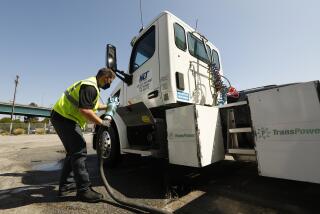Editorial: Trump’s EPA wants to ignore science and put more dirty trucks back on the road
Diesel exhaust fumes are the most foul tailpipe emissions on the road, as anyone stuck in traffic behind an aging bus or 18-wheeler can attest. But researchers have gathered overwhelming evidence that the fumes are more than just unpleasant; diesel emissions contribute to asthma, heart disease, cancer and a host of other ills. Diesel-powered trucks are also major contributors to lung-searing smog, and their emissions are loaded with climate-altering soot and gases that contribute to global warming.
That research undergirds the increasingly strict emissions standards that air quality regulators have been imposing on new trucks sold in the United States over the last 15 years. The newest standards to make trucks more fuel efficient and cut greenhouse gas emissions were adopted by the U.S. Environmental Protection Agency last year.
But never mind public health and science. President Trump’s EPA is trying to reopen a loophole that would let truckers avoid all those pesky and costly clean-air requirements by putting old, dirty engines in new truck bodies. Last month, the EPA proposed waiving the clean truck standards for these so-called glider kits. A final decision is expected next year.
The result of Pruitt’s repeal would be more asthma cases, more emergency room visits and more premature deaths.
We shouldn’t be surprised that the EPA, under administrator Scott Pruitt, would be so willing to sacrifice public health for industry profit. Since taking over in February, Pruitt — who as Oklahoma attorney general challenged more than a dozen EPA regulatory moves — has worked to undercut a wide range of environmental protections. The agency has sought to interfere with at least three dozen regulations, either by ending them outright (as with the Obama administration’s Clean Power Plan) or just by delaying them (as with a regulation meant to reduce explosions at chemical plants).
In the past, glider kits were typically used to give new life to engines and other components salvaged from trucks damaged in collisions. But several years ago, the EPA noticed a surge in glider-kit trucks on the road, from fewer than 1,000 in 2010 to more than 10,000 in 2015, suggesting that some companies were using the vehicles to circumvent truck emissions standards by putting old diesel engines inside new truck shells. The vehicles cost 25% less to buy because they have none of the pollution controls required on newer trucks.
The Obama administration closed the loophole last year as part of the newest clean truck standards. But a small group of glider-kit manufacturers lobbied Pruitt to repeal that part of the truck rules, and he agreed. One of the major manufacturers, Fitzgerald Glider Kits in Tennessee, hosted a campaign event last year for then-candidate Donald Trump, and company executives met privately with Pruitt in May.
Pruitt has justified the repeal by citing research financed by Fitzgerald and by saying that glider trucks are more affordable for smaller trucking companies.
His decision ignores the EPA’s own recent analysis, which found that gliders produced 40 times more smog-forming emissions and 55 times more diesel soot than new trucks. The EPA estimated that gliders make up just 5% of the freight trucks on the road yet account for one-third of the smog and soot emissions from heavy trucks. Those emissions will be even greater if the proposed deregulation leads more companies to deploy glider trucks — a likely result.
It’s worth noting that the nation’s major truck manufacturers and trucking associations urged Pruitt not to reopen the loophole. They said it tilts the playing field, allowing some truckers to skirt clean air rules that other trucking companies have spent heavily to comply with.
The repeal would allow more highly polluting, soot-belching trucks on the road and impose a huge pollution burden on communities near freeways and trucking centers. The result would be more asthma cases, more emergency room visits and more premature deaths. It would make it even more difficult for Southern California to meet federal clean air standards, as heavy-duty diesel trucks emit more smog-forming emissions than any other pollution source in the region. And it would allow a segment of trucks to keep spewing greenhouse gases at a time when the world is trying to slow the pace of global climate change. All this, just to appease a small group of politically connected manufacturers.
Follow the Opinion section on Twitter @latimesopinion and Facebook
More to Read
A cure for the common opinion
Get thought-provoking perspectives with our weekly newsletter.
You may occasionally receive promotional content from the Los Angeles Times.






